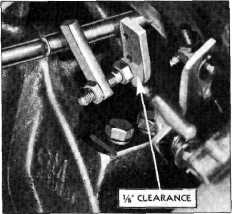1942 - 1947 CHEVROLET SHOP MANUAL
Section 6 - Engine
|
|
|||
|
6-33 |
|||
|
|
|||
|
Coil and Condenser
The
ignition coil is of large capacity and is sealed air tight to prevent the entrance of
moisture. Transformer oil is
used for insulating material inside the coil. A large porcelain
insulator is used at the
secondary terminal of the coil, to provide effective insulation.
The condenser is also of large
capacity to operate with the large
capacity coil and distributor cam angle, and when used with these
units aids in producing high coil voltage, particularly at low engine
speeds.
NOTE—This condenser must not be
installed on models prior to 1941, as its capacity is too high for the
coil and cam angle on these models.
The
ignition coil and condenser should be checked following the instructions given by
the manufacturer of the test
equipment being used.
Fuel Pump
Remove the
pump filter bowl and screen and wash
them thoroughly in clean gasoline. When reassembling make sure the cork gasket is in
good condition and properly seated. Tighten all fuel pump
connections.
Air Cleaner
Remove the
air cleaner, wash the copper filter element in clean gasoline and allow to drain
thoroughly. Dip the element in
engine oil and allow excess
oil to drain thoroughly before reassembly.
Carburetor
Remove the carburetor from the
engine. Disassemble, inspect and
reassemble as outlined under
"Carburetor." All parts should also be checked to make sure they are correct for
the carburetor involved.
Reassemble carburetor and air
cleaner to the
engine.
Throttle Adjustment When Starting
Provision is made on passenger
models for adjusting the amount
of throttle opening when starting the engine through a lug welded to the
starter cross shaft, and a
similar lug containing a bolt and |
check nut
for adjustment, welded to the accelerator rod, Fig 69.
To adjust
the amount of throttle opening when starting, proceed as
follows:
1. Adjust the engine idling speed at 450 to 500
R.P.M.
2. Loosen the lock nut and adjust the bolt in
the accelerator rod lug to
provide 1/8" clearance between its head and the lug on the starter
cross shaft. Fig
70. |
||
 |
|||
|
Fig. 70—Adjusting Throttle Opening for Storting
This
adjustment will provide sufficient throttle opening when starting the
engine.
Manifold Heat Valve
Unhook the
thermostatic spring from its anchor pin and check the adjustment. Proper
adjustment and hook-up requires
only 1/2 turn of the spring from its unhooked position to slip it over
the anchor pin. Should this spring be distorted in any way it
should be replaced.
Valve Adjustment
Start the
engine and while it is warming up, tighten cylinder head bolts, rocker shaft
support bolts and nuts and the
manifold bolts and nuts. Where
tension wrenches are available the cylinder head bolts should be tightened to 75 to 80
foot pounds, and the rocker
shaft support bolts to 25 to 30
foot pounds.
Normalize
the engine and adjust the valves according to the procedure in this section
of the manual under "Valve
Adjustment Procedure."
Install the rocker arm cover,
using a new gasket and check for oil
leaks. |
|||
 |
|||
|
Fig. 69—Passenger Car Accelerator
Rod |
|||
|
|
|||